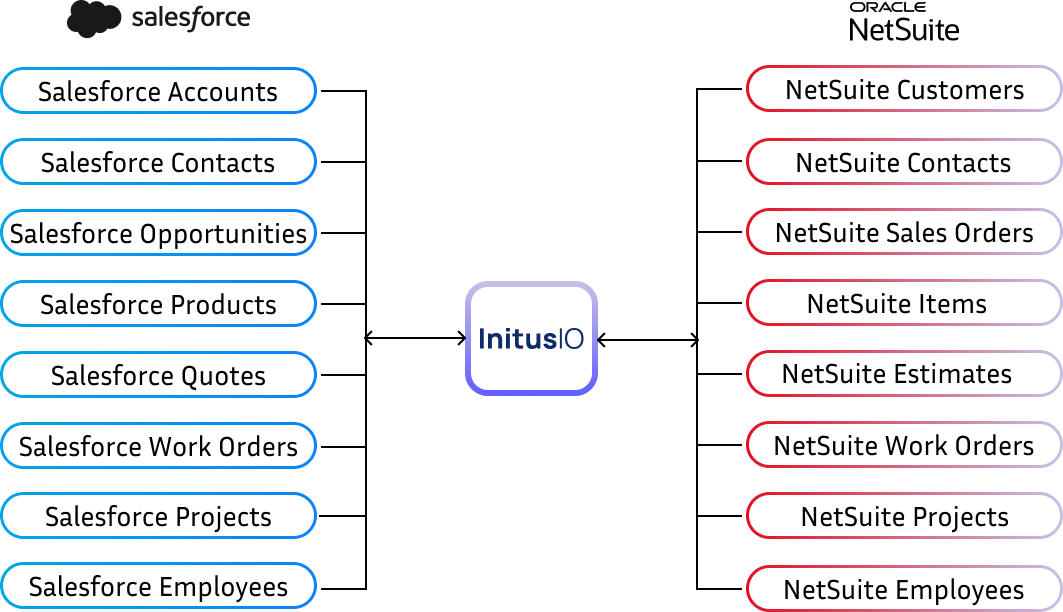The current digital landscape for companies around the globe demands seamless integration and data flow between business systems. With AI advancement and emerging ‘agents’ reshaping the workforce—experts project that 70% of workplace skills will transform significantly by 2030—organizations need robust, integrated solutions to stay competitive. Salesforce in combination with NetSuite is a winning strategy to stay ahead of the competition.
Enter the powerful combination of Salesforce and NetSuite. While each platform excels independently, their integration creates a synergy that transforms business operations. Let’s explore real-world examples of how companies are leveraging this dynamic duo to drive growth and efficiency.
Curious about how integrating NetSuite and Salesforce can elevate your organization? Our experts are here to help! Reach out to us anytime to explore the benefits and get started on your integration journey.
Beyond Theory: Real-World Synergies
While specific details of individual company implementations are often confidential, we can illustrate the impact of Salesforce and NetSuite integration with real world examples based on common use cases:
1. Streamlined Sales Cycle for a SaaS Company:
Imagine a fast-growing SaaS business. Their sales team uses Salesforce to manage leads, opportunities, and customer interactions. Previously, once a deal was closed, the information had to be manually re-entered into NetSuite for order fulfillment, billing, and revenue recognition. This was time-consuming, prone to errors, and created a lag in recognizing revenue. You can dive into this story for more: The Journey of Outreach.io – From Startup to a $1.1 Billion SaaS Company.
By the way, do you know what a Sales Cycle is? According to Salesforce there are 7 critical stages you should know about.
The Solution: Integrating Salesforce and NetSuite automates this process. When a deal is closed in Salesforce, the relevant data automatically flows into NetSuite, triggering the creation of a sales order, generating an invoice, and updating the financial records.
The Benefit: This eliminates manual data entry, reduces errors, accelerates the sales cycle, and provides real-time visibility into revenue. The sales team can focus on selling, and finance has accurate, up-to-the-minute financial data.
2. Enhanced Customer Service for an E-commerce Business:
Consider an e-commerce company that uses Salesforce Service Cloud for customer support. They also use NetSuite for order management, inventory, and fulfillment. A customer calls with a question about their order status.
The Solution: With integrated systems, the customer service representative in Salesforce can instantly access the customer’s order history, shipping information, and even inventory levels directly from NetSuite.
The Benefit: This empowers the rep to provide faster, more informed support, improving customer satisfaction. No more switching between systems or putting customers on hold while searching for information. This is the case for Seaman’s Beverages and Logistics. The NetSuite connection keeps clients compliant with industry regulations across 22 different countries.
3. Improved Inventory Management for a Manufacturing Company:
A manufacturing company (Rossignol, a manufacturer of ski and snow equipment) uses Salesforce to manage customer relationships and sales orders. Their production planning and inventory management are handled in NetSuite. Previously, there was a disconnect between sales forecasts in Salesforce and actual inventory levels in NetSuite.
The Solution: Integrating the two platforms allows sales forecasts from Salesforce to automatically update inventory projections in NetSuite. When a sales order is placed in Salesforce, it immediately reduces available inventory in NetSuite.
The Benefit: This provides real-time visibility into inventory levels, prevents stockouts, optimizes production planning, and improves supply chain management.
4. Data-Driven Insights for a Subscription Service:
A subscription-based business uses Salesforce to manage subscriber information and NetSuite for billing and financial reporting. They want to understand customer churn and identify upsell opportunities.
The Solution: Integrating Salesforce and NetSuite allows them to combine customer data from Salesforce with financial data from NetSuite.
The Benefit: This provides a 360-degree view of the customer, enabling them to analyze churn patterns, identify high-value customers, and personalize marketing campaigns for upselling and cross-selling. Learn How Sourcegraph cut revenue recognition time by 70% with ZoneBilling.
Key Takeaways:
These examples, while generalized, highlight the potential of Salesforce and NetSuite integration. The specific benefits will vary depending on the industry, company size, and specific business needs.
However, the overarching themes are:
✔️ Increased Efficiency: Automating data flow eliminates manual data entry and reduces errors.
✔️ Improved Visibility: Real-time access to information across departments provides a holistic view of the business.
✔️ Enhanced Customer Experience: Faster, more informed interactions lead to happier customers.
✔️Data-Driven Decision Making: Combining data from both platforms unlocks valuable insights for strategic planning.

How data flows between Salesforce and NetSuite
Salesforce
Automatically converts a Salesforce opportunity into a NetSuite order.
Access post-sales transactions such as invoices and payment status within Salesforce.
Get real-time data synchronization between Salesforce and NetSuite.
NetSuite
Attach new orders from current customers into an existing record.
Trigger a lookup in Salesforce for customers using NetSuite Order Creation.
Automatically update billing and shipping contacts from Salesforce in NetSuite.
Integrating Salesforce and NetSuite streamlines data flow between your Customer Relationship Management (CRM) and Enterprise Resource Planning (ERP) systems, enhancing operational efficiency. Here’s an overview of how data typically flows in such an integration:
1. Salesforce to NetSuite:
- Customer Information: When a new customer is added in Salesforce, their details are automatically transferred to NetSuite, ensuring both systems have consistent customer data.
- Sales Orders: Upon closing a deal in Salesforce, the sales order information is sent to NetSuite for order processing and fulfillment.
2. NetSuite to Salesforce:
- Order Status Updates: As orders are processed in NetSuite, status updates are sent back to Salesforce, keeping the sales team informed about order progress.
- Inventory Levels: Real-time inventory data from NetSuite is shared with Salesforce, enabling sales representatives to provide accurate product availability information to customers.
3. Bi-Directional Data Synchronization:
- Financial Data: Payment statuses and financial information are synchronized between both systems, ensuring that sales and finance teams have access to up-to-date data.
- Product Catalogs: Updates to product details in NetSuite are reflected in Salesforce, ensuring consistency across both platforms.
This integrated data flow eliminates manual data entry, reduces errors, and provides teams with real-time information, leading to improved decision-making and customer satisfaction.
For a visual representation of this data flow, you can refer to the flowchart provided by Salesforce Trailhead, which illustrates the integration process between Salesforce and NetSuite.
The synergy between Salesforce and NetSuite offers a powerful solution for businesses seeking to optimize their operations and gain a competitive edge. By seamlessly connecting front-office and back-office functions, companies can unlock new levels of efficiency, improve customer satisfaction, and drive revenue growth.
If you’re considering integrating these two platforms, carefully evaluate your specific needs and contact our team of experts to learn how we can help.
Adaptability + Experience + Strategic Methodology. If you have an operational improvement challenge you want to overcome, contact us today.




